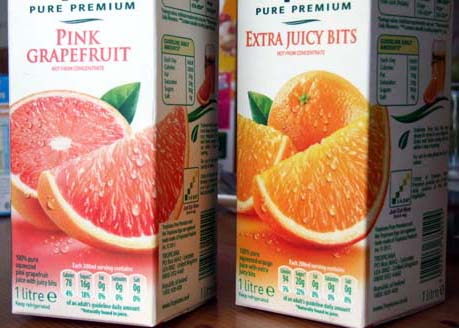Having thought I’d refuted the multiverse explanation of life-origins, I noticed this on the breakfast table today:

Look closely at the sliced grapefruit and the orange. You’ll see they have the same flesh-pattern, the same light reflex, the same moisture droplets. And yet the background shows they’re photos of completely different fruits.
Now, I’ve no way of working out the probability of two fruits of different species turning up in a photo with such matching details. But it must be more than 10^150, surely. Some might say an intelligence was involved, but knowing what Kooning has taught us about probability and the infinite multiverse… well, it’s just what you’d expect, isn’t it?

de Moraes AP, dos Santos Soares Filho W, Guerra M. (2007)
Karyotype diversity and the origin of grapefruit. Chromosome Res. 15: 115-121.
Grapefruit is a group of citrus of recent origin, probably resulting from a cross between pummelo and sweet-orange. Aiming to investigate this putative origin and the genetic variability among grapefruit cultivars, the karyotype of six grapefruits, two pummelos, and one tangelo cultivar (grapefruit x tangerine) were analyzed using sequential CMA/DAPI double staining and FISH with rDNA probes. The karyotypes of grapefruit ‘Duncan’ and ‘Foster’ differ from those of ‘Flame’, ‘Henderson’, ‘Marsh’ and ‘Rio Red’. The former have two chromosomes with a single CMA(+) band in both terminal regions (C type chromosome) and six chromosomes with only one CMA(+) terminal band (D type), whereas the latter have three C and five D type chromosomes. All accessions investigated exhibited two chromosomes with 5S rDNA but a variable number of 45S rDNA. The two former grapefruits displayed four 45S rDNA sites, whereas the remaining grapefruit cultivars had five. The two pummelos showed identical karyotypes, homozygous for CMA(+) bands and their four rDNA sites. From each pummelo chromosome pair one chromosome seems to be present in grapefruit karyotypes. The different grapefruit karyotypes might result from independent crosses between pummelos of different karyotypic constitution and sweet-oranges. The chromosome markers found in the tangelo ‘Orlando’ and the position of their two 45S rDNA confirm the grapefruit ‘Duncan’ and the tangerine ‘Dancy’ as their parents.